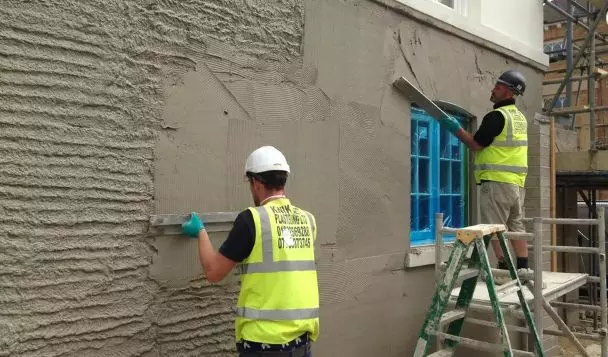What's the difference between Weberend OCR and Weberend Aid

Rendering an existing building or new build can be achieved with a number of Weber solutions. Here's the lowdown on two key products
Equipment list:
-
Render Mesh Cloth (Open-weave glass fibre mesh cloth to reinforce monocouche renders)
They say don’t judge a book by its cover but when it comes to a property’s exterior, let’s face it, we all do. Achieving the perfect exterior is what we all strive for but what kind of products can help to contribute towards this? As you know, renders are not adhesives and require a combination of suction and mechanical key to bond to its substrate when rendering outside walls.
Key to success: Weberend Aid
Enter weberend aid, a key (preparatory) coat which can be used to improve the application of render onto poorly keyed surfaces, for example, smooth concrete, or by providing suction control across substrates of uneven or high suction. It can be used on dense concrete, brickwork, blockwork, and masonry.
Always read the instructions carefully as this product should never be used on gypsum plaster or painted surfaces.
Once the stipple coat has been applied you can use weberend OCR, a premixed sand and cement render, which is suitable for rendering brickwork, blockwork, and concrete, among other suitably prepared substrates.
Note: A stipple or key coat may not always be required before rendering – its use will vary depending on the substrate being rendered onto.
Quick guide to using weberend aid and weberend OCR
1/ Prepare surfaces
Ensure that residue is removed from all areas leaving a clean and dry surface. Any materials or residue can interfere with the bond of materials to be applied.
2/ Apply the key coat weberend aid (2-3mm thick approximately 1m² at a time), textured immediately with a stipple roller to leave a deep, heavy, stipple key. Treat all elevations to be rendered. Cure as necessary.
3/ Render application
There are several renders out there so apply and finish your choice as directed for the relevant materials. You can use weberend OCR and a synthetic finish or a monocouche render such as weberpral M.

What is it?
A polymer-modified sand and cement stipple render.
How is it used?
Used as a preparatory key coat before applying render.
Includes an integral bonding agent so it requires only the addition of clean water on site.
Benefits
- Improves key prior to application of render onto a smooth or otherwise unsuitable but sound surface.
- Provides excellent suction control across both high and low suction substrates.
- Resists the penetration of external water to improve the weather resistance of rendering systems.
- Quality controlled and factory blended for consistency.
- Easy to apply by hawk and trowel before finishing with a stipple roller.
Available in 25kg bags.
Things to bear in mind
Do not use if frost is forecast within 24 hours of use and not suitable for use in damp or wet conditions.

What is it?
A pump or hand applied one coat render. Ideal as a base for decorative finishes such as cullamix tyrolean and weberplast TF.
How is it applied?
In one coat, providing results equivalent to traditional two coat renders.
Benefits
- weberend OCR avoids the drying time associated with multi-coat render systems and offers results equivalent to traditional two coat renders.
- Resists the penetration of external water and has excellent weather resistance and durability, whilst allowing the structure to breathe.
- Factory batched for consistency.
- Gives the same final appearance as a traditional sand and cement render mix but in significantly less time.
Available in 25kg bags.
Things to bear in mind
- Do not use if frost is forecast within 24 hours of use and not suitable for use in damp or wet conditions.
- Do not apply over previously painted surfaces.
- Do not apply in temperatures below 5°C or above 30°C.
- Do not apply in direct sunlight or where substrate is hot

Find out how to apply these products on our YouTube page